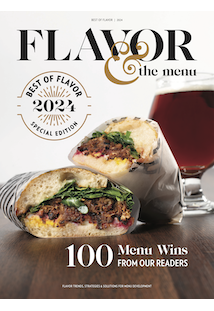

Humans have been consuming honey for at least 8,000 years. It’s certainly not a new discovery, nor is it underappreciated. Chefs, bakers, pastry chefs and beverage developers have long leveraged honey’s round, full, rich, lingering flavor profile. Today, they are now looking at this primal, ancient ingredient through the lens of modern menu development, applying techniques that optimize honey’s flavor and familiarity while lifting it with unexpected touches.
Smoked honey is a key feature in the Buffalo sauce coating the wings at The Train Shed in St. Louis, while floral and earthy saffron honey accompanies ricotta fritters at Bäco Mercat in Los Angeles.
In Nashville, Tenn., Tempered Café & Chocolate’s creamed honey plays a starring role in a baguette sandwich of prosciutto and Gouda.
Butter & Cream, an ice cream shop in Decatur and Atlanta, Ga., turns to honeycomb candy for textural play against its honey ice cream in the Honeycomb Forest.
A snack of Pumpkin Chips at Commons Club at the Virgin Hotels Chicago stands out with a honey-hibiscus foam.
“With honey, you get depth of flavor that’s light years beyond sugar,” says Pam Smith, RDN, nutritionist and culinary consultant. “If you take it to the next step and look at varietals, like lavender or Tupelo honey, you get that depth, but now you’re adding a sense of place. Then you apply culinary technique, like fermenting or whipping or smoking. That leads to opportunity for signature menus.”
Underpinning the sheer value of creative menu play are honey’s enchanting story of hive to table, its differences in varietals, the romance of beekeeping, and its strong footing as a natural sweetener. Also, consumer perception of honey has shifted in the last few years, fixing it with a glowing health halo of functional benefits. Of course, the plight of bees is a serious topic. Honey-centric innovation can help draw attention to the issue, giving restaurant concepts an opportunity to support efforts that work toward saving bee populations.
From an innovation standpoint, the resounding success of hot honey has encouraged more menu play. Consumers have embraced the nuances at work in hot honey, where a cooling depth calms the heat without masking flavor. That positive response has given chefs the green light for further exploration.
As evidence, look to the Spicy Salami Pizza at Mia’s Italian Kitchen in Orlando, Fla. It features honey infused with Calabrese chiles.
Bill Telepan, executive chef at Oceana in New York, serves a side of fingerling sweet potatoes sous vide in Espelette pepper and wildflower honey, then roasted to order.
Honey’s knack for delivering balance cannot be overstated. It is a major pillar fortifying this opportunity. A growing number of consumers get excited about menus that offer intriguing flavor play. Bitter. Funky. Savory. Smoky. Spicy. Honey brings equilibrium to all of them, deftly stepping on the scale with a rich, sweet roundness of flavor.
Fermented Honey
Fermented honey is showing up on more menus, adding intrigue along with nuance of flavor that is both sweet and slightly sour. Although formulas vary, the essentials for making it are honey, water and brewer’s yeast. By adding water, honey’s sugar content is reduced, allowing the needed microbial growth.
Its emergence on the scene points to a spiked use of fermented flavors on menus, coupled with today’s creative honey innovation.
At H2O Seafood & Sushi, with two locations in New York, the Miso Brûlée Roll features lobster, avocado, hamachi, tuna and honey miso, using honey to balance fermented notes.
Lechon in Portland, Ore., serves Peruvian Fried Chicken Bites with fermented hot honey, introducing a bit of sourness to the sweet heat and helping to differentiate its version in an evocative way.
 California Milk Advisory Board
California Milk Advisory Board Brandon Hicks, executive chef of Zino in Berkeley, Calif., spikes honey with Aleppo pepper for his spiced honey dip, served with Cheese Cigars filled with feta and mozzarella.
INSTANT MESSAGING
Honey’s narrative has always been a compelling one, but its story seems to resonate more deeply with consumers today. Terroir comes to life in honey, through tales of meadows, forests, flowers and rooftop oases. “There’s a romance to honey that is valuable for foodservice operators,” says Gabriel Caliendo, VP of R&D for Lazy Dog Restaurants.
To bring a sense of place into a multi-unit concept, he suggests sourcing local honey from different regions across the country, then calling it out on the menu. “It’s fun to experiment with local varietals,” he says. Last spring, he featured a Vanilla Bean Custard topped with local hive honey, candied almonds, bee pollen and fresh berries.
Caliendo has also made a honey brittle, pulverized it, then used it as a crystalized honey rim on a lemon-honey cocktail. He recently did beverage R&D around mead, an alcoholic drink made with fermented honey and water. He added huckleberries, turning it a beautiful fuchsia. Although there are no current plans to put mead on the menu, it’s something he’s playing with.
Jamie Simpson, executive chef liasion of the Culinary Vegetable Institute (CVI), fell hard for honey and honeybees in 2013. “From the first moment I saw a swarm of bees in the sky, I was in love,” he says. “It was a special moment that changed my life.” Since then, he’s been keeping bees at CVI, going from one hive to 16 to 45, now harvesting about 1,200 pounds of honey a year. Simpson underscores the sway of honey’s narrative. “It connects people with where their food comes from. That’s powerful.”
Passionate chefs like Simpson, along with hotel brands and restaurant concepts dedicated to the cause, have been instrumental in drawing attention to the importance of honeybees and the art of beekeeping.
The Row Hotel at Assembly Row in Somerville, Mass., partnered with The Best Bees Company to welcome two hives of Italian honeybees to its protected alcove off the rooftop. To celebrate its housemade honey, the hotel introduced two honey-based cocktails: the Apple Butter Old Fashioned and the Honey Sickle Drop.
At Omni Amelia Island Plantation Resort in Amelia Island, Fla., Daven Wardynski, director of F&B, oversees an apiary that produces palmetto honey, with 2.5 million bees yielding thousands of pounds of local honey featured throughout the hotel’s restaurants.
Responsible Honey Production
There are countless stories like these, all telegraphing the specialness of honey and the importance of working toward preserving bee populations. For those who wonder how consuming honey helps the cause: the National Honey Board’s stance reads, in part: “Eating honey is not harmful to bees because producers promote best practices that support bee nutrition, well-maintained apiaries, and the appropriate application of pest control. Modern beekeepers also pay special attention to clean forage and hive placement.”
Simpson also points out that responsible honey producers offer a good solution to help save the bees. “Our farm started with 450,000 honeybees last season,” he says. “We ended with six times that. We put more bees in the world, pollinated more flowers.”
Bryan Weaver, executive chef of Butcher & Bee, an eclectic American restaurant with one location in Nashville, Tenn., and one in Charleston, S.C., incorporates as much honey onto his menu as possible. “Our name makes honey a must, but we also use it because we see a natural shift happening, where people don’t want white sugar,” he says. “We source our honey from our community—that’s special.”
 Andrew Cebulka
Andrew Cebulka Whipped Feta with a pool of fermented honey is a top-selling shareable at Butcher & Bee, with locations in Nashville, Tenn., and Charleston, S.C.
SWEET INNOVATION
With such a fantastic launching point, there’s opportunity to create inspiring menu items using honey in flavor-forward, inventive ways. At Butcher & Bee, the Whipped Feta Dip with fermented honey is a top seller. “Almost every table gets it. It’s addictive—I call it our Middle Eastern queso,” says Weaver.
The dip sees feta, cream cheese, basil and garlic whipped until light and airy, then paired with housemade fermented honey. Weaver adds the liquid from fermented Serrano chiles to the local honey, then lets it darken and thicken. “It’s sweet, salty, spicy and sour and just works on all levels,” he says. He’s used the fermented honey in a vinaigrette, as well as on a burger. Butcher & Bee sells it to guests, too.
Hot honey continues to grow on menus, with chefs running with the combination and introducing intrigue and dimension beyond sweet and heat. At Ace Eat Serve in Denver, which specializes in modern Asian cuisine, the Korean Fried Chicken Bao with napa cabbage and scallion stars a gochujang chile-honey glaze on the chicken, giving it a richer, funkier flavor.
Hive & Honey, a rooftop bar in Irvine, Calif., takes the incredibly familiar combination of fries and ketchup and turns it into something memorable in its fries with jalapeño-honey ketchup.
Chicago’s Ēma, a Mediterranean concept from Lettuce Entertain You, maintains its sense of place with its Aleppo-honey bacon, served at brunch.
 Christina Slaton
Christina Slaton A side of bacon at Ēma in Chicago gets sweet heat from a blend of honey and Aleppo pepper.
Ian Ramirez, director of culinary innovation and operations with Creative Dining Services, uses fermented honey to help pickle raisins in his Grilled Caulilini with golden cashew cream, pickled raisins, fried capers and pistachios. He adds golden raisins to fermented honey, regular honey, star anise, cinnamon and cloves. “Fermented honey is great in a pickling liquid,” he says. “It adds a vinegary taste with a back note of round, sweet flavor.”
Ramirez showcases another unique way to leverage honey in his Honey-Smoked Salmon Jerky. He cures the salmon in brown sugar and avocado honey that’s been infused with cubeb pepper, a chile with floral, warm notes.
Creamed honey is less familiar, but offers a wonderfully thick, velvety texture. “It’s got great visual presence,” says Pam Smith. “Use it instead of butter or whipped cream, on toast or as an element of a cheese board.” It also works at the bar. At Kingfisher Bar in Durham, N.C., a gin cocktail called Bee Durham features a chamomile creamed honey.
Modern flavor building requires balance and depth—honey offers that in spades. Chefs are pushing into new frontiers of flavor infusions and formats with honey, giving diners the exciting flavor experiences they seek.
 Morgan Tucker
Morgan Tucker Jamie Simpson perfected honey-infused marshmallows, describing them as floral and aromatic. He subbed out corn syrup with honey and added cane sugar and isomalt to the marshmallow formula to help stabilize its structure.







